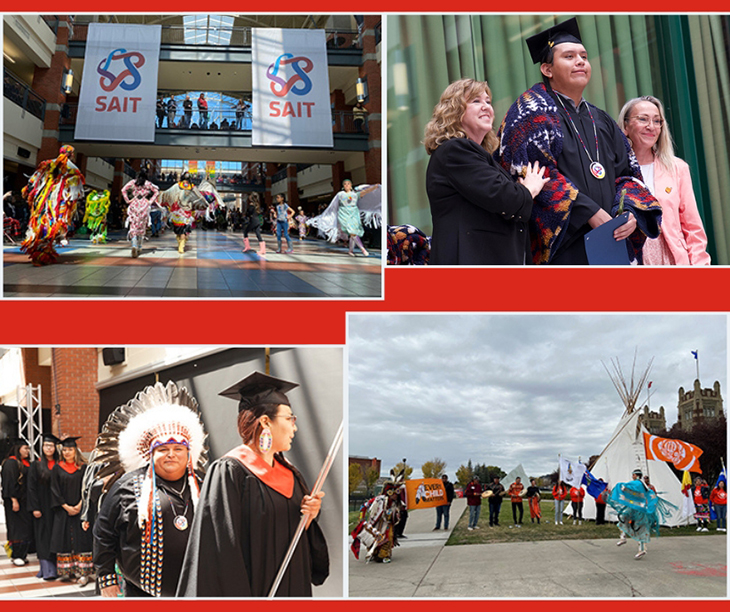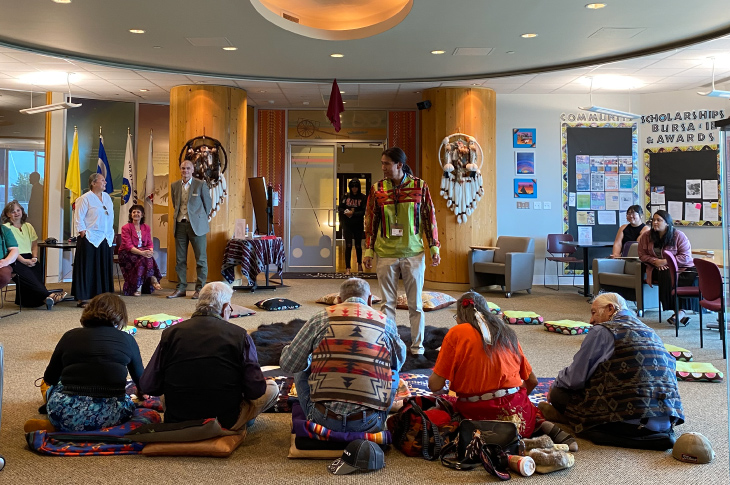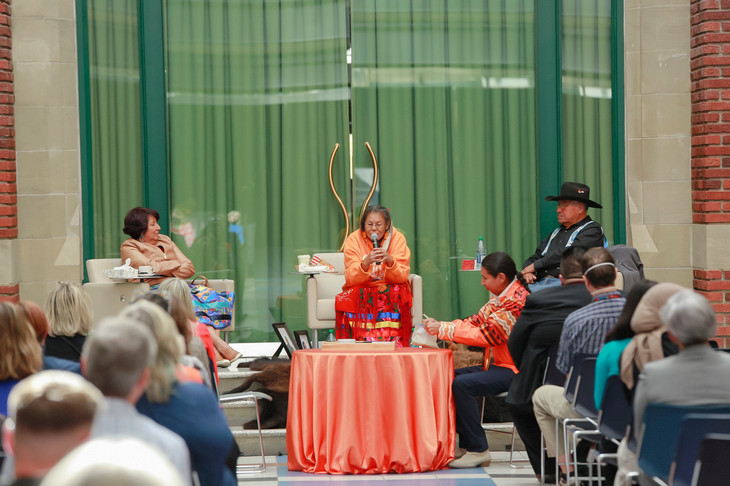SAIT’s path to Indigenization

From internal growth to education opportunities and increasing Indigenous visibility on campus, SAIT continues decolonization efforts and working to remove systemic barriers to Indigenous success
This June — when we observe both Indigenous History Month and National Indigenous Peoples Day — SAIT is reflecting on the commitments we’ve made and the steps we continue to take on our Truth and Reconciliation journey. Last year, we hired Jennifer Russell, Director of Indigenous Engagement, to champion initiatives that support the success of Indigenous students, employees and communities.

Indigenous graduation celebration
Mid-June, 2,400 new SAIT grads crossed the stage during our convocation ceremonies, and we topped off the week with our Indigenous Graduation Celebration.
The celebration is steeped in tradition and ceremony to honour our First Nations, Métis and Inuit graduates. It’s an opportunity for SAIT’s Indigenous community to come together with friends and family in celebration.
The afternoon included a traditional grand entry procession led by Indigenous drummers with graduates and volunteers carrying flags from the nations of Treaty 7, Métis Nation, Nunavut, Canada, Alberta and SAIT, as well as the Survivors’ Flag.
A feast was held in honour of families who travelled to join the celebration to thank them for their journey. Feasting is an important ceremonial piece of Indigenous culture — to gather, break bread and enjoy a meal together to celebrate community and success.
Graduates received traditional gifts bestowed during significant life milestones which are culturally symbolic of an extremely high honour. Métis students received a sash and First Nations students received an eagle feather.
Lastly, a blanket ceremony was held to bring together the physical and spiritual worlds. Each graduate stands as a blanket is ceremonially lifted to their shoulders four times — for the east, south, west and north — symbolizing prayers for physical, mental, emotional and spiritual well-being. Once wrapped around the graduate, the blanket will be their strength and protection as they begin a new journey.

Renaming SAIT’s Indigenous space
A new name was given to SAIT’s Indigenous student support space, formerly known as Chinook Lodge.
The word “Chinook” isn’t found in Treaty 7 languages, and resource centre Manager, Steve Kootenay-Jobin, Na’toya Piik’ski (Holy Bird) wanted to honour local Indigenous language.
“With the new name, our students will see themselves reflected to an even greater degree within the institution and have a space with a name that strengthens the Indigenous worldview of the education experience,” says Kootenay-Jobin.
During a traditional Blackfoot pipe ceremony in July 2023, Elder Miiksika'am (Clarence Wolf Leg) of Siksika Nation presented the centre with a new name — Natoysopoyiis (nah-toy so-poh-yees), which means “holy wind lodge” in the language of the Blackfoot people.
When sharing the meaning of the new name, Elder Miiksika'am described it as the wind carrying a sudden wet snowstorm which blankets the ground bringing moisture for the earth and life below. “This wind teaches us to prepare for unexpected weather change — like in life and unforeseen circumstances.”
Natoysopoyiis serves as a safe space for Indigenous students at SAIT to express and reflect their identities, culture and spirituality while on their educational journey. The Lodge is a place for students to connect to the land and traditional ceremony by accessing supplies needed to care for their mental, emotional and spiritual health.

Indigenous Knowledge Keeper joins the team
In Indigenous communities, a Knowledge Keeper refers to someone who has been taught traditional knowledge and ceremony and cultural protocols by an Elder or a senior Knowledge Keeper within their community.
Thomas Snow joined SAIT to share teachings and foster the connection between SAIT’s campus community and Indigenous culture. He provides guidance on when and how it is and is not appropriate to share this knowledge with others.
Intersectional representation at SAIT’s International Women’s Day Conference
On her one-year anniversary as SAIT’s Director of Indigenous Engagement, Jennifer Russell presented to the SAIT community and beyond about the historical and present-day power of Indigenous women in Canada. As keynote speaker, Russell — who has Cree and Blackfoot relations and is a member of the Métis Nation of Alberta — delved into the vital role Indigenous women played in the success of Canada’s first economy, the fur trade, and shone a light on the women continuing to drive change in the country today.
4 Seasons of Reconciliation offered at SAIT
SAIT introduced the 4 Seasons of Reconciliation course for employees in early 2024, and for students as of June 21 — in partnership with First Nations University of Canada. Those who complete the training gain foundational knowledge on Truth and Reconciliation and earn a certificate.
The course, along with its online resources, promotes a renewed relationship between Indigenous peoples and Canadians through transformative and engaging anti-racism education. This learning is in direct response to the 94 Calls to Action from the Truth and Reconciliation Commission of Canada and the importance of educating all Canadians in workplaces and classrooms.
SAIT’s Truth and Reconciliation Event Series
Leading up to Sept. 30 — the National Day for Truth and Reconciliation and Orange Shirt Day — SAIT held a Truth and Reconciliation Event Series to reflect our commitment to an inclusive and culturally sensitive learning environment. The initiative gave our community the opportunity to engage in meaningful conversations and gain deeper insights into Indigenous and Canadian histories, experiences and perspectives.

During an emotionally impactful survivors’ panel, Treaty 7 Elders and Survivors Alice Kaquitts, Betty Crazyboy and Miiksika'am shared their truth of what was experienced by Indigenous children in the residential school system and the intergenerational impacts on their families and communities. The week’s event culminated with the SAIT community coming together to honour the children of the residential school system in a march led around campus by Treaty 7 dancers, drummers and flag bearers carrying the Canadian, Alberta, Treaty 7, Métis, Inuit and Every Child Matters flags as a symbol of unity on our Truth and Reconciliation journey.

Oki, Âba wathtech, Danit'ada, Tawnshi, Hello.
SAIT is located on the traditional territories of the Niitsitapi (Blackfoot) and the people of Treaty 7 which includes the Siksika, the Piikani, the Kainai, the Tsuut’ina and the Îyârhe Nakoda of Bearspaw, Chiniki and Goodstoney.
We are situated in an area the Blackfoot tribes traditionally called Moh’kinsstis, where the Bow River meets the Elbow River. We now call it the city of Calgary, which is also home to the Métis Nation of Alberta.